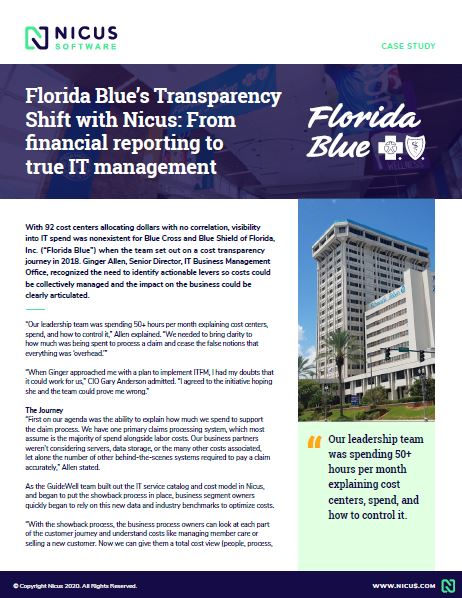


With 92 cost centers allocating dollars with no correlation, visibility into IT spend was nonexistent for Blue Cross and Blue Shield of Florida, Inc. (“Florida Blue”) when the team set out on a cost transparency journey in 2018. Ginger Allen, Senior Director, IT Business Management Office, recognized the need to identify actionable levers so costs could be collectively managed and the impact on the business could be clearly articulated.
“Our leadership team was spending 50+ hours per month explaining cost centers, spend, and how to control it,” Allen explained. “We needed to bring clarity to how much was being spent to process a claim and cease the false notions that everything was ‘overhead.’”
“When Ginger approached me with a plan to implement ITFM, I had my doubts that it could work for us,” CIO Gary Anderson admitted. “I agreed to the initiative hoping she and the team could prove me wrong.”
“First on our agenda was the ability to explain how much we spend to support the claim process. We have one primary claims processing system, which most assume is the majority of spend alongside labor costs. Our business partners weren’t considering servers, data storage, or the many other costs associated, let alone the number of other behind-the-scenes systems required to pay a claim accurately,” Allen stated.
As the GuideWell team built out the IT service catalog and cost model in Nicus, and began to put the showback process in place, business segment owners quickly began to rely on this new data and industry benchmarks to optimize costs.
“With the showback process, the business process owners can look at each part of the customer journey and understand costs like managing member care or selling a new customer. Now we can give them a total cost view (people, process, technology, vendors) that can be compared with industry benchmarks, and they can make decisions on their own – how and where they/we can lower admin costs,” Allen explained.
Pairing new-found transparency with a partnership mentality, Allen and her team now approach conversations with business segment owners quite differently.
“Now, when looking at the P&L with each business partner, we can have conversations about the cost to acquire a customer, desired profits, and remaining funds to service those customers. It helps them think through their own business models, product design, etc.,” Allen noted. “Previously, they [business segment owners] were planning for a whole dollar and not understanding how half of it was spent. They are now doing a better job planning – factoring in changing admin costs benefiting growth and the net impact to profit margin.”
“With automation and new capabilities enabled, each stakeholder can focus on optimizing costs, lowering rates, and increasing sales,” Allen added. “That’s business value.”
In a recent presentation with the Management Team, Allen and team member Robert Bogusch highlighted some key outputs from the 18-month journey with Nicus. For the first time, demonstrating total cost of ownership for an Application (like the claim processing system previously mentioned). Allen and Bogusch were able to present the App TCO detail- including costs associated with running & supporting each application from the servers that power it, the database dependencies, the tools required to monitor performance and security, and data storage and disaster recovery.
The demo continued with “fully-loaded” development staff rates (including salary and the related costs of training, travel, and the tools needed to perform their services) and distribution reports that included leadership and overarching costs, and how to drill down by initiative.
“The entire team (including our CEO) is energized by what we’ve built and what’s to come with Nicus. Our CFO, who’s worked for several Fortune 100 companies, remarked he’s never, in his tenure, seen this level of reporting before,” Allen beamed.
Allen and team are focusing on continuing actionable conversations (beyond defending spend and non-value-add discussions). Prioritized efforts have been put in place to continue cleansing data, pulling all general ledger spend through the model to avoid “peanut butter spread” costs and cuts, partnering business partners with IT partners, and maturing IT Service Management.
“This is not just financial reporting anymore. This is IT Management,” CIO Gary Anderson concluded.